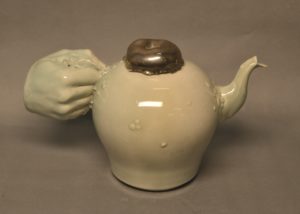Oldrich Asenbryl

(b. 1943, Ceske Budejovice, Czechoslovakia) lives and works in Sarn, North Wales
Teapot with Hand and Letter, 1975
porcelain, graphite, glaze, 10.25 x 8 x 7 inches, 93.39.130ab
After receiving a well-rounded education in ceramic production at the Bechyne College of Ceramics, Oldrich Asenbryl was on holiday in 1968 when the Russian army invaded his home country of Czechoslovakia. Stranded in the foreign country of Great Britain with no good pathway home, Asenbryl found a job throwing pots for the master British ceramicist Alan Caiger-Smith. Two years later, he opened a production studio with his colleague Simon Rich, selling brightly colored functional ware to the people of Wiltshire. After three years of saving, Asenbryl was able to move to North Wales, where he built a spacious studio and opened a shop in the nearby village of Sarn.
In the spring of 1971, under the auspices of the International Academy of Ceramics, the Tennessee Arts Commission pledged its support for the promotion and establishment of the U.S. International Ceramic Symposiums. The Symposium’s mission to help develop a worldwide network of support for ceramic art was achieved by bringing together top ceramic artists from around the world for a month-long sharing of ideas and creation of innovative ceramics.


Left: Asenbryl throwing porcelain on the wheel at the 1975 International Ceramic Symposium. Right: Photo from the 1975 ICS catalogue. Additional images below
Asenbryl represented Great Britain at the Second U.S. International Ceramic Symposium, which consisted of twelve artists representing seven different countries, and was hosted in the summer of 1975 at the Arrowmont School of Crafts in Gatlinburg, TN. He used his time at the Symposium as an opportunity to explore a breadth of experimental ideas, or as he told the Gatlinburg Press, “[I am] trying new things that I’ve had on my mind for a long time. I also have time to think and talk here.”[1] This attitude, combined with expert wheel throwing skills and training as a plaster mold maker, led to exciting and unique forms that merged traditional pottery with slip castings. A perfect example of this hybrid way of working are Asenbryl’s “self-pouring” teapots, which elegantly fuse castings of the human hand with thrown forms. Even more unorthodox, one work created at the Symposium involved casting a hog’s head sourced from a local Sevierville slaughter house, and mounting the cast head atop a tall sculptural base.

Hog’s Head, 1975, stoneware, 28 x 12 x 13 inches, 93.39.230
In the years since the Symposium, Asenbryl has operated Sarn Pottery, a production studio and storefront in North Wales where he and his wife Jenny sell “the finest selections of handmade craft pottery in Wales.”[2] He has continued learning and incorporating new techniques into his practice, and has started using a clay hand extruder brought from the Symposium as part of his regular practice. A serious stroke in 1983 paralyzed Asenbryl on the left side of his body, leaving him unable to create ceramics as he did before. Through perseverance, he has adapted his technique to throw simple forms one-handed using extremely soft clay, and has focused his energy into painting their colorful and stunning glazes, which are inspired by the spontaneity of jazz and American pop art.
In addition, Asenbryl has served as a lecturer in the arts department at British universities in Cardiff, Newport, Belfast, and in Bechyne, Czechoslovakia. He participated in the 1987 ceramic symposium in Aberystwith, Wales, and the 1999 ceramic symposium in Walzbrych, Poland. His art can be found in the collections of the Fitzwilliam Museum in Cambridge, the Ashmolean Museum in Oxford, and the York Art Gallery in England.
I have now discarded the intellectual approach to one-of-a-kind pieces and try to direct all my creative energies to making good quality, standard ware. This is sold mostly in the summer months to passerby from my Sarn Pottery outlet. […] Here, I am able to sell almost all my pots retail, and in the process have the opportunity for a satisfying chat with customers. I am fortunate to have learned that in whatsoever state I am therewith to be content.[3]
[1] “Eminent Ceramicists.” Gatlinburg Press. September 9, 1975.
[2] www.sarnpottery.co.uk
[3] Asenbryl, Oldrich. A Potter in Wales. Ceramics Monthly. February, 1989. Pages 26-27.
Written by Aiden Layer, TN Arts Intern


Left: Jar With Face, 1975, Porcelain, gold, luster, 7 x 5.25 x 5.25 inches, 93.39.131ab Right: Jar With Apple, 1975, porcelain, celadon, gold, glaze, 6.26 x 5.75 x 3.5 inches, 93.39.61ab


Left: Porcelain Teapot with Silver Top, 1975, porcelain, celadon, silver, luster,8 x 12 x 6.5 inches, 93.39.8ab Right: Flat Teapot, 1975, porcelain, celadon, 7.5 x 8.5 x 6.5 inches, 93.39.254ab

Jar, 1975, porcelain, celadon, gold, glaze, 9.5 x 4.25 x 4.25 inches, 93.39.129ab

